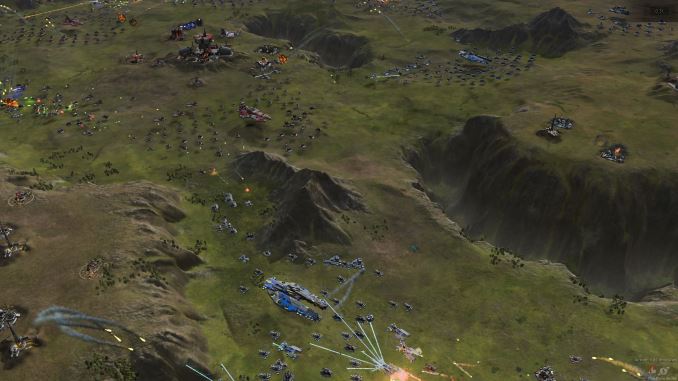GeForce + Radeon: Previewing DirectX 12 Multi-Adapter with Ashes of the Singularity
by Ryan Smith on October 26, 2015 10:00 AM ESTFirst Thoughts
Wrapping up our first look at Ashes of the Singularity and DirectX 12 Explicit Multi-Adapter, when Microsoft first unveiled the technology back at BUILD 2015, I figured it would only be a matter of time until someone put together a game utilizing the technology. After all, Epic and Square already had their tech demos up and running. However with the DirectX 12 ecosystem still coming together here in the final months of 2015 – and that goes for games as well as drivers – I wasn’t expecting something quite this soon.
As it stands the Ashes of the Singularity multi-GPU tech demo is just that, a tech demo for a game that itself is only in Alpha testing. There are still optimizations to be made and numerous bugs to be squashed. But despite all of that, seeing AMD and NVIDIA video cards working together to render a game is damn impressive.
Seeing as this build of Ashes is a tech demo, I’m hesitant to read too much into the precise benchmark numbers we’re seeing. That said, the fact that the fastest multi-GPU setup was a mixed AMD/NVIDIA GPU setup was something I wasn’t expecting and definitely makes it all the more interesting. DirectX 11 games are going to be around for a while longer yet, so we’re likely still some time away from a mixed GPU gaming setup being truly viable, but it will be interesting to see just what Oxide and other developers can pull off with explicit multi-adapter as they become more familiar with the technology and implement more advanced rendering modes.
Meanwhile it’s interesting to note just how far the industry as a whole has come since 2005 or even 2010. GPU architectures have become increasingly similar and tighter API standards have greatly curtailed the number of implementation differences that would prevent interoperability. And with Explicit Multi-Adapter, Microsoft and the GPU vendors have laid down a solid path for allowing game developers to finally tap the performance of multiple GPUs in a system, both integrated and discrete.
The timing couldn’t be any better either. As integrated GPUs have consumed the low-end GPU market and both CPU vendors devote more die space than ever to their respective integrated GPUs, using a discrete GPU leaves an increasingly large amount of silicon unused in the modern gaming system. Explicit multi-adapter in turn isn’t the silver bullet to that problem, but it is a means to finally putting the integrated GPU to good use even when it’s not a system’s primary GPU.
However with that said, it’s important to note that what happens from here is ultimately more in the hands of game developers than hardware developers. Given the nature of the explicit API, it’s now the game developers that have to do most of the legwork on implementing multi-GPU, and I’m left to wonder how many of them are up to the challenge. Hardware developers have an obvious interest in promoting and developing multi-GPU technology in order to sell more GPUs – which is how we got SLI and Crossfire in the first place – but software developers don’t have that same incentive.
Ultimately as gamers all we can do is take a wait-and-see approach to the whole matter. But as DirectX 12 game development ramps up, I am cautiously optimistic that positive experiences like Ashes will help encourage other developers to plan for multi-adapter support as well.











180 Comments
View All Comments
MobiusPizza - Monday, October 26, 2015 - link
It's the same shades that's why you can't distinguish between them. But you are not suppose to distinguish them by shades, but by the bar length! They correspond to different graphic quality profiles. The longest is obviously "Normal average", middle is "Medium average" and shortest the "Heavy average".jmke - Monday, October 26, 2015 - link
Ashes of the Singularity = Supreme Commander remake?wonder how it will compare, since SupCom is pretty much cream of the crop when it comes to large scale RTS
CaedenV - Monday, October 26, 2015 - link
This is rather impressive! Was thinking about updating my GPU this winter... but maybe my 'ol 570 can limp along a little longer to see how this technology shapes up. Perhaps getting 2 decent midrange cards from different vendors to get exclusive rendering tech would be a smarter move than getting a single high-end card.Manch - Monday, October 26, 2015 - link
or competing game bundles!Murloc - Monday, October 26, 2015 - link
it seems to me that it's a few years off...nos024 - Monday, October 26, 2015 - link
So...does that mean we can use Freesync or Gsync with this combo?extide - Monday, October 26, 2015 - link
It would probably depend on which card is the leader -- although there was a checkbox for FreeSync in the screenshot so, maybe the game has to support it? It's not entirely clear at the moment.Ryan Smith - Monday, October 26, 2015 - link
Yes, Ashes supports Freesync. It should probably support G-Sync as well, but only Freesync has been explicitly mentioned so far (and as you note, it's even a settings option).WaltC - Monday, October 26, 2015 - link
I should think this will soon filter-down into the engine-development area, where the engine that developers elect to use will support (or not) these nice capabilities. For the odd game that still requires a home-grown engine--yes, the impetus will be up to the developer.Refuge - Tuesday, October 27, 2015 - link
To be honest, this is exactly what I'm hoping happens.